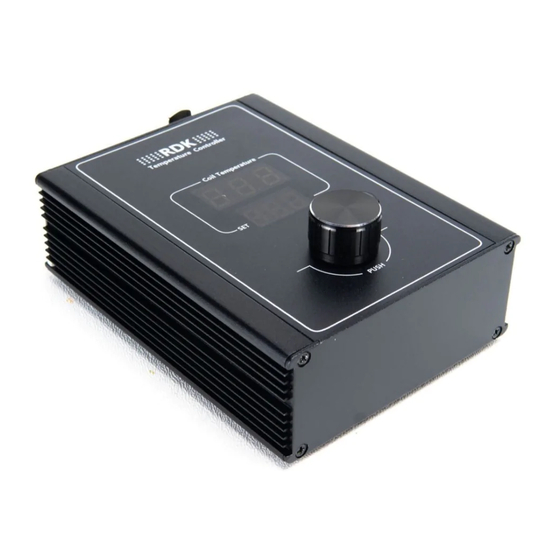Auber RDK-300B Manuel d'instruction - Page 2
Parcourez en ligne ou téléchargez le pdf Manuel d'instruction pour {nom_de_la_catégorie} Auber RDK-300B. Auber RDK-300B 4 pages. For hot runner coil heater

AUBER INSTRUMENTS
Standard
Operating
Mode
Coil Temperature
3 0 0
knob
knob
Press and
3.0 0
hold knob
SET
for 5
seconds
Standard
Operating
Mode
Coil Temperature
3 0 0
3.0 0
SET
Figure 2. Flow chart of how to access a menu.
3. Boost mode settings (access code 122)
A boost mode is an operating mode on RDK-300B that allows the user to
quickly cycle between two set temperatures, a lower standby temperature and
a higher boost temperature, by simply pressing down the control knob. There is
no need to turn the knob back and forth to adjust for the desired set
temperature. A boost mode also allows the user to set up a boost timer which
automatically lowers the set temperature from boost to standby after a period
of time.
Three (3) boost modes are available, which are named as "b-1", "b-2", and
"b-3". There are three parameter settings for each boost mode: standby
temperature (x-S), boost temperature (x-B), and boost timer (x-T), where "x"
represents the boost mode number. A user can adjust and save customized
settings for each mode in the menu of 122.
Table 1. Parameters for boost modes (code 122).
Symbol
Mode
Description
Standby temperature
1-S
Boost temperature
1-B
B-1
Boost timer
1-T
2-S
Standby temperature
2-B
B-2
Boost temperature
2-T
Boost timer
3-S
Standby temperature
3-B
B-3
Boost temperature
3-T
Boost timer
Details about each boost mode setting
x-S. Standby temperature. It is a relatively low set temperature at which the
user feels comfortable to leave the coil heater for a long time when the heating
system is not in use. The standby temperature must be lower than the boost
temperature.
x-B. Boost temperature. It is a high set temperature at which the user is going
to use the coil heater. The boost temperature must be higher than the standby
temperature.
2020.05
LOCK
Adjust menu
screen
access code
Coil Temperature
Coil Temperature
L ck
knob
knob
Rotate
.
0
knob to
SET
SET
change
code
First
pa rameter in
the 122
menu
Coil Temperature
Go through
1 - S
the menu
.
300
SET
Range
0 ~ Boost Temp.
Standby Temp. ~ 999
OFF, 1-999
0 ~ Boost Temp.
Standby Temp. ~ 999
OFF, 1-999
0 ~ Boost Temp.
Standby Temp. ~ 999
OFF, 1-999
x-T. Boost timer. It is a timer for boost temperature. Once the timer is reached,
the controller will automatically switch set temperature back to the standby
L Ck
temperature. A user can also deactivate the boost timer by setting it to "OFF",
which means the set temperature will remain at the boost temperature till the
.
122
user press down the control knob.
4. Temperature control parameters (access code 166)
Press down
knob
knob
This group of parameters is for adjusting the temperature control performance.
Table 1 shows the list of parameters, their range and the initial factory settings.
For most heating coils and nails on the market, the P, I, and d do not need to
be changed. Please do NOT change them unless you are very familiar with
manually tuning PID controllers. In most cases where the control result is not
ideal, adjusting the "oth" should be able to solve the problem.
Table 2. Temperature control parameters and the initials (code 166).
Symbol
Display
P
I
D
oth
c-f
apo
Details about each parameter
P. Proportional band. The unit is in degrees. This parameter controls the
output of the controller based on the difference between the measured and
set temperature. The larger the P value, the weaker the action (smaller gain).
For example, if P = 7, the proportional band is 7 degree. When the sensor
temperature is 7 degrees below the set point, it is out of the proportional
band, and the controller will have 100% output. When the temperature is 5
Initial
degree below the set point, the output is 71%. When the temperature is
300°F
equal to the set point, the controller will have 0% output (assuming integral
550°F
and derivative functions are turned off). This constant also affects both
OFF
integral and derivative action. Smaller P values will make the both integral
300°F
and derivative action stronger.
550°F
OFF
I. Integral time. The unit is in seconds. This parameter controls the output of
300°F
controller based on the difference between the measured temperature and
the set temperature integrated with time. The integral action is used to
550°F
eliminate temperature offset. Larger number means slower action. For
OFF
example, when the difference between the measured and the set
temperature is 2 degrees and remains unchanged, the output will increase
continuously over time due to the contribution of the integral term until it
reaches 100%. If the temperature fluctuates up and down constantly
(system oscillating), increase the integral time I. If the controller is taking too
long to eliminate the temperature offset, decrease the I. Usually this
parameter does not need to be changed.
d. Derivative time. The unit is in seconds. The derivative term contributes to
the output power based on the rate of temperature change. Derivative action
can be used to minimize the temperature overshoot by responding to the
rate of temperature change. The larger the d value, the faster the reaction.
WWW.AUBERINS.COM
Description
p
Proportional band (in 0.1 degree)
I
Integral constant (second)
D
Derivative constant (second)
OTH
Output high limit
C-F
Temperature unit
APO
Auto power-off timer
Range
Initial
0-999
125
0-999
60
0-999
10
0-100
100%
C or F
F
OFF,
60
1-999
P2/4
